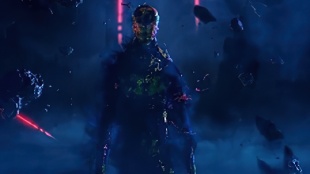您需要 登录 才可以下载或查看,没有账号?注册

x
本帖最后由 对bu起 于 2022-8-18 11:46 编辑

Introduction
Hey readers! My name is Allen Vu and I’m a 3D Environment and Material Artist. I was recently a graduate student studying for my doctorate and working in a hospital. When I was deciding what to do with my life, I let go of my dreams of going to art school and went down the healthcare route. Unsurprisingly, I wasn’t happy with anything I was doing at school. I was miserable and unfulfilled, I felt lost, but after a lot of encouragement from my friends and internal reflection, I decided to turn to game art.
介绍
嘿,读者们!我的名字是Allen Vu,我是一名3D环境和材料艺术家。我最近是一名研究生,正在攻读博士学位,并在一家医院工作。当我决定如何对待我的生活时,我放弃了去艺术学校的梦想,走上了医疗保健的道路。不出所料,我对学校做的任何事情都不满意。我很痛苦,没有满足感,我感到迷茫,但在朋友的鼓励和内心反思之后,我决定转向游戏艺术。
At first, it started slowly. I would get home from work, study for my exams, and watch a few tutorials or read a couple of articles on the basics: modeling, texturing, and general skills. The more I learned, however, the more I wanted to make this daydream into a career. It only took a global pandemic to finally push me into the deep end. I uprooted my life and fully dedicated myself to game art. I took a couple of classes to get a better understanding of the basic workflows. My daydream was gaining momentum and soon I had enough courage to invest in a more advanced class that would help push my skills. I signed up for an environment building course on CGMA with Anthony Vacarro, and that was where I began the Cedar Forest level.
起初,它开始得很慢。我会下班回家,学习考试,看一些教程或阅读几篇关于基础知识的文章:建模,纹理和一般技能。然而,我学到的越多,我就越想把这个白日梦变成一种职业。直到一场全球大流行,我才终于把我推入了深渊。我背井离乡,全身心地投入到游戏美术中。我上了几节课,以便更好地理解基本的工作流程。我的白日夢正在獲得發展,很快我就有足夠的勇氣投資於更進階的課程,這將有助於提高我的技能。我和Anthony Vacarro一起报名参加了CGMA的环境建设课程,这就是我开始Cedar Forest级别的地方。

The Cedar Forest Project
The prompt for the class was simple: design an organic level in Unreal Engine 4. With such an open-ended assignment I had a lot on my plate, especially since this was going to be the first environment I designed. My main goal for the class was to finish with something I could present. I love primordial spaces and places untouched by people, so I wanted a woodland-type scene, something with a wild and overgrown look.
When it came to gathering references, I started with ideas of the plants I wanted to fill this biome with. I started with evergreen trees, eventually landing on cedars, and let my ideas snowball, figuring out what plants grew with them and what climate zones they lived in. I then started including rock types, lighting scenarios, and compositions in my searches. I was actively trying to cover all my bases in reference gathering while also building this environment in my head. I utilized the references I gathered throughout the entire process trying to figure out what details and pieces of each reference I wanted to utilize in my scene.
雪松森林项目
上课的提示很简单:在虚幻引擎4中设计了一个有机关卡。有了这样一个开放式的任务,我有很多东西要做,特别是因为这将是我设计的第一个环境。我上课的主要目标是用我能呈现的东西结束。我喜欢原始空间和未被人触及的地方,所以我想要一个林地式的场景,一种具有狂野和杂草丛生的外观。
在收集参考资料时,我从我想用这个生物群系填充的植物的想法开始。我从常绿树开始,最终降落在雪松上,让我的想法滚雪球,弄清楚哪些植物与它们一起生长,以及它们生活在什么气候区。然后,我开始在搜索中包括岩石类型,照明场景和构图。我积极地试图在参考收集中涵盖我的所有基础,同时在我的脑海中建立这个环境。我利用了我在整个过程中收集的参考资料,试图弄清楚我想在场景中使用每个参考资料的细节和片段。
Modeling
When the time came to start modeling assets for my scene, I took the rough elements that I used for blockout and started to sculpt them in higher detail using Maya and ZBrush. Since this project was meant for a class and I wanted to learn as much as I could, I did not use any premade elements and started everything from scratch. I paid special attention to the rocks and trees, starting in Maya by getting the shapes that I wanted.
Then I brought the elements into ZBrush and sculpted the details with a bunch of different alphas and brushes, sculpting larger details and then focusing on where I wanted the smaller details. At this stage, I was using my reference board to try and capture any details that I thought were important for selling the assets like rocks and trees.
建 模
当需要开始为我的场景建模资源时,我采用了用于遮挡的粗糙元素,并开始使用 Maya 和 ZBrush 以更高的细节雕刻它们。由于这个项目是为一门课准备的,我想尽可能多地学习,所以我没有使用任何预制的元素,而是从头开始一切。我特别注意岩石和树木,从玛雅开始,获得我想要的形状。
然后,我将元素带入ZBrush,并用一堆不同的alpha和画笔雕刻细节,雕刻更大的细节,然后专注于我想要的小细节。在这个阶段,我使用我的参考板来尝试捕捉我认为对出售岩石和树木等资产很重要的任何细节。
After I got to a point where I was happy with how the models looked, I baked down the high poly versions onto low polys, brought them into UE4, and started replacing the blockout assets. At this point, the scene was really just white rocks and trees, but I wanted to try and focus on nailing the composition before I added more. In my mind, I wanted to create a space that a character could walk through and explore, so I mapped out the paths and points of interest.
在我对模型的外观感到满意之后,我将高多边形版本烘焙到低多边形上,将它们引入UE4,并开始替换块资源。在这一点上,场景实际上只是白色的岩石和树木,但我想在我添加更多内容之前尝试并专注于确定构图。在我的脑海中,我想创造一个角色可以走过和探索的空间,所以我绘制了路径和兴趣点。
Texturing
When I was happy with some of the bigger elements, I decided to move on to texturing and creating smaller foliage assets. The rocks and trees were textured using tiling PBR materials, and I utilized the Substance Suite to create procedural textures as well as photogrammetry.
For one of my textures, I decided to go outside and take a picture of a tree in order to create a texture using Substance Alchemist. The rock textures were made in Substance 3D Designer, but I wanted to give myself options. To accomplish this, I kept them relatively simplistic, not incorporating too much detail and breakup. I wanted to make the textures more complex by layering them with some noises in the engine material shader. I sculpted tiling materials in ZBrush and used those to bring out the detail I wanted, layering the high poly bakes with material and noise Normal maps.
纹理
当我对一些较大的元素感到满意时,我决定继续进行纹理化和创建较小的树叶资源。岩石和树木是使用平铺PBR材料进行纹理处理的,我利用Substance Suite来创建程序纹理以及摄影测量。
对于我的一个纹理,我决定去外面拍一棵树的照片,以便使用物质炼金术士创建纹理。岩石纹理是在Substance 3D Designer中制作的,但我想给自己选择。为了实现这一目标,我让他们保持相对简单化,没有包含太多细节和分手。我想通过在引擎材质着色器中使用一些噪声来分层纹理,从而使纹理更加复杂。我在ZBrush中雕刻了平铺材料,并用它们来突出我想要的细节,用材料和噪音法线贴图分层高多边形烘焙。
Set Dressing & Composition
When the scene was coming to life with the textures, I began to focus on the look I wanted to achieve. This ranged from color correcting the rocks to lightening the bark textures. I accomplished most of those edits in the engine with the material shader. Afterward, I brought in some of the plants that I molded and started painting them through my landscape using the UE4 Foliage brush. After placing them down randomly, I went through with a fine-toothed comb to curate how I wanted the foliage to appear. I started setting up my shots, finding the best angles to show off the assets and points of interest I had created. I placed camera actors and locked them in position, so I could jump back in and tweak the composition as I changed the scene elements.
布景和构图
当场景随着纹理而栩栩如生时,我开始专注于我想要实现的外观。这从颜色校正岩石到减轻树皮纹理不等。我使用材质着色器在引擎中完成了大部分编辑。之后,我带来了一些我模制的植物,并开始使用UE4 Foliage画笔在我的风景中绘制它们。在随机放置它们之后,我用一把细齿梳子来整理我想要的叶子如何出现。我开始设置我的镜头,找到最佳角度来展示我创建的资产和兴趣点。我把摄像机演员放在适当的位置,这样我就可以跳回去,在改变场景元素时调整构图。
Things were starting to really come together and I was halfway done with my class. But then, something happened in my Unreal scene where all the foliage duplicated itself, destroying the frame rate. It was to the point where I couldn’t even work in the scene without turning off the detail lighting and all the laid-out foliage.
I decided to press forward anyway so that I could at least have something finished for the class. It was almost unbearable working in the scene because of how slow it was. For the next two to three weeks, I continued adding elements and moving things around in a stop motion fashion due to how bad the scene was chugging.
事情开始真正走到一起,我的课程已经完成了一半。但后来,在我的虚幻场景中发生了一些事情,所有的树叶都复制了自己,破坏了帧速率。我甚至无法在场景中工作,除非关闭细节照明和所有布局的树叶。
无论如何,我决定继续前进,这样我至少可以为这门课做点什么。在场景中工作几乎是无法忍受的,因为它的速度太慢了。在接下来的两到三周里,由于场景的摇晃有多糟糕,我继续添加元素并以定格动画的方式移动东西。
Final Touches
If I thought the set dressing was bad with a low frame rate, the lighting was going to be a rude awakening. For this scene, I wanted to use dynamic lighting because I had multiple lighting scenarios in my mind and I couldn’t just pick one. UE4’s lighting system is complex and has a lot of options you can play with to get a number of results. I wanted to use that to my advantage and create a bunch of different moods. I spent days playing with the directional light and sky light to get the right colors and interactions with the volumetric fog. I continued to layer them until I got the result I wanted for a specific shot.
最后的润色
如果我认为布景的打扮很糟糕,帧率低,那么照明将是一种粗鲁的觉醒。对于这个场景,我想使用动态照明,因为我的脑海中有多个照明场景,我不能只选择一个。UE4的光照系统很复杂,有很多选项可以让你玩,以获得许多结果。我想利用这一点来发挥我的优势,创造一堆不同的情绪。我花了几天时间玩定向光和天空光,以获得正确的颜色以及与体积雾的相互作用。我继续将它们分层,直到我得到我想要的特定镜头的结果。
Again, I used my reference board, looking at all the scenes I collected to find the details I could replicate. I set up post process volumes throughout the environment and tweaked the saturation and hues to match the moods I was going for, adding yellows to warm up a scene or drawing out the blues to add depth to the fogs.
I took some screenshots and decided that those would be what I submitted as my final project in the class. Even though I finished the course, I knew I wasn’t done with the environment. There were still so many issues with the project and I wasn’t completely happy with it yet.
再一次,我用我的参考板,查看我收集的所有场景,以找到我可以复制的细节。我在整个环境中设置了后期处理体积,并调整了饱和度和色调以匹配我想要的情绪,添加黄色以预热场景或绘制出蓝色以增加雾的深度。
我拍了一些截图,并决定这些将是我在课堂上作为最终项目提交的内容。即使我完成了课程,我也知道我还没有完成环境。这个项目还有很多问题,我对它还没有完全满意。
Round 2
The first thing that I desperately needed to change was the performance issue. The foliage being duplicated unnecessarily was the biggest thing affecting the FPS. It made working in the scene difficult and definitely slowed my process. I made the decision to remove all the foliage from the scene and start the set dressing over from square one. I also decided to set up LODs for most of my assets, especially the foliage, and to remove the post process volumes I had set up.
When I began set dressing again, I placed cameras earlier so that I could pay more attention to composition. My scene was performing much better and stayed between 27-30 FPS while working, which significantly sped up the development. Removing the post process volumes and getting the same effects only with lighting and fog also helped increase performance. I was going to try for six shots again but eventually decided to diminish my scope and focus on three. My thought process was that three strong shots would be better than six okay shots.
第 2 轮
我迫切需要改变的第一件事是性能问题。不必要地复制树叶是影响FPS的最大因素。它使在现场工作变得困难,并且肯定减慢了我的过程。我决定从场景中移除所有树叶,并从原点开始穿衣。我还决定为我的大多数资产(尤其是树叶)设置 LOD,并删除我设置的后期处理卷。
当我再次开始穿衣时,我提前放置了相机,以便我可以更加注意构图。我的场景表现要好得多,在工作时保持在27-30 FPS之间,这大大加快了开发速度。删除后期处理体积并仅使用光照和雾获得相同的效果也有助于提高性能。我打算再次尝试六次拍摄,但最终决定缩小我的范围并专注于三次。我的思考过程是,三次强力投篮会比六次好的投篮更好。
In my second attempt, set dressing took half the time and yielded completely different and better results. I had an improved understanding of what I wanted in my scene, and it really helped me focus on the look I was going for. When I was ready to move on to lighting, I needed to redo all my scenarios because each scene had completely changed. I wanted the lighting to complement the composition, so I exaggerated the colors and contrast in some areas to push the focal point. I also wanted to bring more life to my scene, so I decided to add simple wind to move the branches around and created some particle effects in UE4’s Cascade system. The embers, mist, and dust were all made in the engine and helped add movement and variation to the shots.
在我的第二次尝试中,布景敷料花了一半的时间,产生了完全不同且更好的结果。我对我想要的场景有了更好的理解,这真的帮助我专注于我想要的外观。当我准备转向照明时,我需要重做我所有的场景,因为每个场景都完全改变了。我希望照明能够与构图相辅相成,因此我夸大了某些区域的颜色和对比度,以推动焦点。我还想为我的场景带来更多的生命力,所以我决定添加简单的风来移动树枝,并在UE4的级联系统中创建了一些粒子效果。余烬,雾气和灰尘都是在发动机中制造的,有助于增加镜头的运动和变化。
Conclusion
As I was approaching the end of the project, it became increasingly harder to concentrate on just one thing. I was conflicted, fluctuating between trying to figure out if I needed more in the scene or if I should just trash the whole environment and start over. Do I tell myself to stop and be happy with what I had or do I keep pushing forward to try and make it better and better? I think as artists the biggest lesson we can learn is that art is never done, the artist just decides to stop. Eventually, I believed that the amount of time I had put in was well worth it and I was ready to put down the brush. This project was such a huge learning experience for me. As hard as it was, it really took me from being an admirer to a full-fledged artist.
结论
随着项目接近尾声,我越来越难以专注于一件事。我很矛盾,在试图弄清楚我是否需要在场景中获得更多,或者我是否应该丢弃整个环境并重新开始之间摇摆不定。我是告诉自己停下来,为我所拥有的一切感到高兴,还是继续努力,试图让它变得越来越好?我认为作为艺术家,我们能学到的最大教训是,艺术永远不会完成,艺术家只是决定停止。最终,我相信我投入的时间是值得的,我准备放下刷子。这个项目对我来说是一次巨大的学习经历。尽管这很难,但这真的让我从一个崇拜者变成了一个成熟的艺术家。
Sometimes in life, things don’t go your way, be it in a career or in a project. Unexpected hurdles can have you laid out flat on your back, but you can’t be afraid to get up and, sometimes, start over completely. Usually, on the second try, you’ve grown a lot and learned from your mistakes. It’s not easy and there are bound to be hiccups, but you’ll be better off for it and probably much happier with the outcome.
有时在生活中,事情不会按照你的方式发展,无论是在职业生涯中还是在项目中。意想不到的障碍可能会让你平躺在你的背上,但你不能害怕站起来,有时,完全重新开始。通常,在第二次尝试时,你已经成长了很多,并从错误中吸取了教训。这并不容易,肯定会有打嗝,但你会因此而变得更好,并且可能对结果更满意。
I think the biggest lesson that I have taken away from this project is to never give up and to know when to give up and try again. If there is anything I can leave the reader with, it is this: keep going! Trip, jump, and run to reach the finish line (or in this case, the stopping line), you’re closer than you think.
Special thanks to my teachers Max, Peyton, and Anthony for mentoring me through the process and to Zach, my friends, and family for the support so far!
我认为我从这个项目中得到的最大教训是永远不要放弃,知道什么时候放弃,再试一次。如果有什么我可以留给读者的,那就是:继续前进!绊倒,跳跃和奔跑以到达终点线(或者在这种情况下,停止线),你比你想象的更接近。
特别感谢我的老师Max,Peyton和Anthony在整个过程中指导我,并感谢Zach,我的朋友和家人迄今为止的支持!
|








 评分
评分






